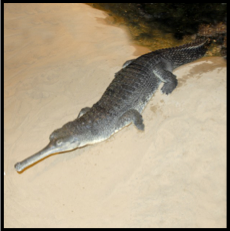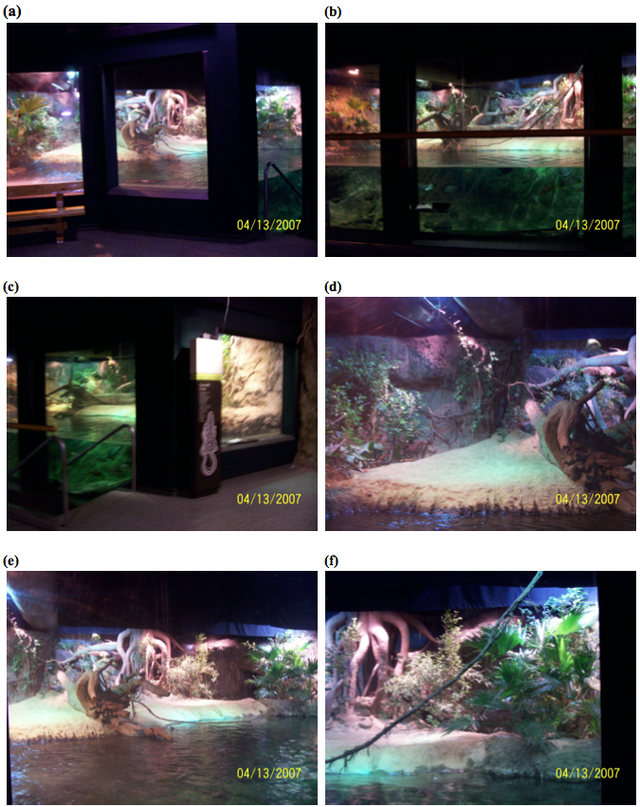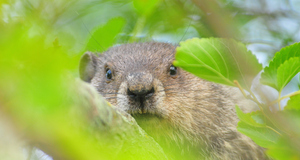From Discussions VOL. 4 NO. 1Gharial (Gavialis gangeticus) Habitat Use and Behavior Analysis in Response to Repeated Aggression
IN THIS ARTICLE
KEYWORDS
AbstractGavialis gangeticus, the Indian gharial, is the only extant gharial species in the world. The gharial is a large crocodilian in the family Gavialidae and is characterized by a long snout. Due to its sparse numbers and increased habitat destruction, its behavior as compared to other living crocodilians remains relatively unknown. This particular specimen, located at the Cleveland Metroparks Zoo, was a female of approximately 28 years. The study was done in order to determine causes for aggression towards certain species of fish in the gharial‟s enclosure. These species of fish were too large for the gharial to consume and thus would not represent a prey item to the gharial. It was hypothesized that limited enclosure space led to increased aggression in the gharial. However, throughout the course of the study no attacks on fish were recorded, but stereotyped swimming by the gharial was seen. It was noted that the gharial displayed less stereotypical swimming when the public was present than when people were not observing the enclosure. These results suggest that the public could be a source of stimulation for the gharial and thus could reduce negative behaviors in the captive gharial. INTRODUCTIONThe Indian gharial, Gavialis gangeticus, is the only extant species of gharial left in the world (Vliet 2001). The gharial is a member of the order Crocodilia, which also includes crocodiles, alligators, and caimans. It is in the family Gavialidae and is characterized by its long, narrow snout. The males are distinguished by the large, bulbous "ghara" on the tip, hence the common name "gharial" (Whitaker 1982). This adaptation is due to the fact that its main diet is the fish that inhabit these rivers, such as tilapia, and that the gharial tends to dwell in fast flowing river systems, although it is often found in outcrops of these rivers where the water flow is slower (Whitaker 1982). It is well adapated for this aquatic environment since the long, narrow snout allows for less water resistance when catching fish. Therefore, the gharial is the most aquatic member of the crocodilians, and also the only member whose diet is mainly characterized by fish (Whitaker 1982). The only natural populations of gharial are found in India, specifically in the river systems of the Indus (Pakistan), the Ganges (India and Bangladesh), the Brahmaputra (Bhutan), and Mahanandi (Orissa) (Whitaker 1982). The population was nearly decimated in the 1970s, but local organizations were then formed, and are still heavily in existence, in order to breed these animals in captivity and release them back into the wild (Whitaker 1982). Due to the specificity of its habitat and the rather small population, the gharial remains a mystery in terms of its behaviors, and even most basic life characteristics. Captive populations in the United States are minimal, with single specimens at the Cleveland Metroparks Zoo (female), San Diego Zoo, National Zoo, and the largest population at St. Augustine Alligator Farm in Florida. There are many complications in forming a breeding population within the United States, including the difficulty of transporting adults within the country and the necessity of shipping only juveniles from overseas due to the fragility of their snouts. Therefore, there is not currently a breeding couple in the country. Gharial life spans are thought to be similar to other crocodilians of large size and late maturity and tend to be upwards of 100 years (Whitaker 1982). Their reproductive status is also like other crocodilians, in that size, not age, determines when they become reproductively active. This generally happens upon reaching over 3 m in length for females and 4 m for males, although there have been exceptions to the rule in smaller individuals in India (Whitaker 1982). The average adult size ranges from 3.5 m to 4.5 m (Brazaitis 2001), but males are known to reach 6-7 m (Whitaker 1982). They are believed to be the most timid and least aggressive and territorial of the known crocodilians, however it is to be emphasized again that very few have been studied. The gharial‟s social displays are similar to those of the other members of the crocodilian order. These displays include the dominance display (head and tail emerging erect out of the water or merely a snout lift out of water, and acoustic signals, including subaudible vibrations and grunts/bellows) and other dominance displays such as headslaps and jawclaps (Vliet 2001). Many of these displays are also associated with reproduction, mainly used by males to attract females. Territoriality is also seen amongst males, as is demonstrated by dominance displays, bellows and headslaps/jawclaps. However, the gharial is not believed to be as territorial as other crocodilians. In general, unless finding territory, attracting a mate, or acquiring food, crocodilians conserve energy either in the water, the primary home of the gharial, or by basking on the sandy banks. Aggression in captivity is seen more often than in the wild due to the restraints on the animal‟s territory and habitat. Categories in which environments can negatively affect the captive animal include, but are not limited to, inconsistencies in substrate, temperature, auditory ranges (specifically infrasonic with respect to crocodilians), lighting conditions, diet, isolation from conspecifics, and cage size (Vliet 2001). The effect of restricted movement due to limited space has frequently been studied, and has been found to be a major contributor to stress and stereotyped behavior (Morgan 2006). Stereotyped behavior consists of any behavior that is uncommon or absent in wild populations or is detrimental to the animal‟s health. It is also common for animals under a certain type of stress, such as excess noise from humans, to respond to this stressor in a seemingly unrelated manner, like lack of movement. Therefore, it is important to explore all aspects of an animal‟s environment in order to understand why a negative behavior is being elicited (Morgan 2006). Over the period of 45 days, the gharial at the Cleveland Metroparks Zoo killed a giant gourami, a knifefish, a tinfoil barb, and on two separate occasions bit two giant gouramis. In each of these instances, the fish was not eaten. Thus, the basis of the study was to better understand the basis of the attacks by analyzing the gharial‟s habitat use, time management, and social behavior. METHODS AND MATERIALSThe study was done at the Cleveland Metroparks Zoo in Cleveland, Ohio. One female gharial, Gavialis gangeticus, inhabited the exhibit (Fig 1). Figure 1. Female gharial located at Cleveland Metroparks Zoo.
The subject was obtained in 2003 from Silver Springs after having been in several zoos in the United States. The subject was approximately 28 years old and 2.98 m long from snout to tip of tail; it was believed that the female had not yet reached reproductive status, and most likely will never reach this status due to the size of its enclosure. It was also blind in one eye, which the keepers at the zoo believed was due to an injury at a previous zoo. This disorder, however, had been proven to not affect the captive gharial‟s ability to consume food or to interact with other specimens in a shared exhibit (Singh 1981). The specimen at the Cleveland Metroparks Zoo had never been heard making any of the audible signals. In fact, gharials in general do not vocalize (Vliet 2001). The gharial had rarely shown dominance displays, one of which was witnessed during observation, allowing accurate descriptions of the specimen‟s behavior. The exhibit was shared with two female Batagur turtles (also known as Giant River Terrapins), one female and one unknown Callagur turtles (also known as Painted River Terrapins), one Hamilton‟s Pond Turtle, one female New Guinea Snapping Turtle, one male and one female Orlitas (Giant Malyasian Turtles), one clown knifefish, and fifteen tinfoil barb (though during the experiment one of these was eaten by the gharial). The habitat was divided into sections. The front of the exhibit consisted of clear glass and the remaining walls were covered with artificial foliage. The water portion was 9m x 3.5m and approximately 9000 gallons (Fig. 2a-c). The left portion of the land, left of the log (a) (Fig. 2d) was about 2m x 2m and the right portion was approximately 4.5m x 1.5m (Figs. 2e, f). The land was composed of artificial tan-colored sand. Underwater were various logs and sticks. In the left front corner of the exhibit was a source of flowing water, which often caused bubbles in the water (Fig. 2a). It was noted that the subject was only fed on Thursday mornings, during which no observation occurred. However, one Friday morning feeding was observed to take baseline information about the feeding behavior of this particular specimen. Figure 2. Photographs of the gharial exhibit. (a) left water=LW (b) middle water=MW (c) right water= RW (d) left L (f) right land=RL
Experimental Design. An ethogram was developed based upon previous knowledge of the gharial (Appendix I). Reproductive, social, and territorial displays were kept to a minimum and combined in the categories given in the ethogram due to the lack of other animals. The possibility of these displays shown to human observers was considered, and therefore these measures were not completely left out of the ethogram, however only those that keepers had seen (the dominance displays and general swimming, basking, and passive activities) were developed in the ethogram. Fiveminute behavior scans were taken for a period of 120 minutes each day; this was done three days a week, two in the afternoon and one in the morning, from February 5 through April 13, 2007. There were a total of 1260 morning minutes and 2220 minutes of scans in the afternoon. The behaviors studied for the scanning behavior were swimming, basking, feeding, walking (this can be on land or on the ground underwater), interacting with other exhibit-mates, and passivity (which includes any lack of movement). It was decided that interaction with exhibit-mates would be eliminated from further calculations since it never occurred. The position in the habitat was noted: left water (LW) (Fig. 2a), middle water (MW) (Fig. 2b), right water (RW) (Fig. 2c), left land (LL) (Fig. 2d), middle land (ML) (Fig. 2e), and right land (RL) (Fig. 2f). Also recorded was if the subject was distant (>1m), close (<1m), or touching another species in the exhibit. These three groupings were calculated separately. Each category within the grouping was taken as a percentage of time by dividing the amount of times it was recorded by the total number of scans. These were then averaged, and standard error was calculated. The all-occurrence behaviors recorded were dominance display, which consists of an erect tail and head (Vliet, 2001) emerging from the water, a grunt, a headslap on the water, and a snap at another animal in the exhibit. The all-occurrence behaviors were simply tallied as a total. The subject was also observed by its keepers to seem to gravitate towards the public presence. Therefore each scan period it was noted if the public was present, and if the subject oriented its body, specifically its snout, toward the visitors.Continued on Next Page » Suggested Reading from Inquiries Journal
Inquiries Journal provides undergraduate and graduate students around the world a platform for the wide dissemination of academic work over a range of core disciplines. Representing the work of students from hundreds of institutions around the globe, Inquiries Journal's large database of academic articles is completely free. Learn more | Blog | Submit Latest in Biology |





















